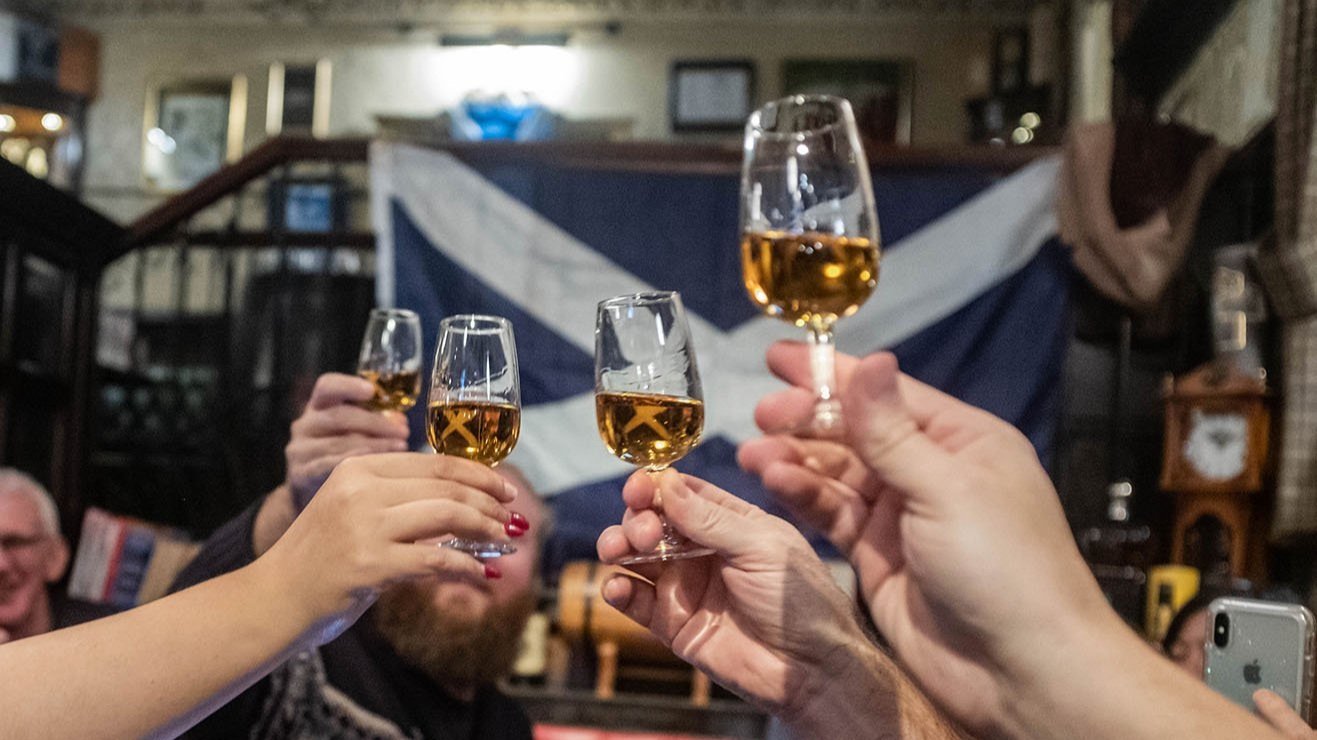Tobermory 17yo PX
2004/2021 Distillery hand-fill | 56.7% ABV
Score: 4/10
Some promise.
TL;DR
More of a whiskied sherry than a sherried whisky
How much sherry is too much?
Or: how I learned to stop worrying and love the distillery visit halo effect.
Today I’m going to touch on two subjects: Can you try something at a distillery, then feel very different about it later? And, in the dregs, whether it’s possible to have too much sherry. The preface is rife with spoilers because the topics are deeply intertwined with my experience with this bottle. Think of it like a movie where you start at the end, then spend the movie unravelling events of the last few days, weeks, or months until you arrive at the end again.
So what’s the end? It’s me sitting at a tasting with a group of friends, proudly popping the bottle and pouring a round, then, upon first whiff, I hear the declaration “Oh, I hate this!”. Cue the movie pause with voice-over: “This is me. How did I get here? To find out, let’s rewind a bit”:
Rewind to September 2021, with a lovely visit to the Tobermory distillery on the pretty Isle of Mull. I managed to lug my extended family out there and opted for the warehouse tour that included a tasting inside a dunnage warehouse. I’m tempted to exclude the memory of the massive IBC tanks of gin that *may* have dampened the experience, but I can’t help myself. In the end it actually didn’t matter! It was such a charming town (or at least a picturesque waterfront), and my excitement was high, as I love distillery visits and special tastings.
In other words, I had the Distillery Halo Effect. Have you ever experienced it? Everything you taste is great! You want all the things! We tasted this very bottle, along with a few others that included a tasty but overpriced 21 year old 1995 for £350. I loved this 2004 full maturation PX cask, and happily trotted over to the shop afterward to buy some bottles. Having arrived with lingering COVID protocols, I was unable to hand-fill myself, so I patiently waited as they did it in the back room. I even remember a woman coming in, exclaiming “do you have any more of the 2004 PX hand fill? My husband said it’s the best Scotch he’s ever had!” I was fortunate and confident in my choice.
So we loved our visit, I loaded up on bottles, and we carried on with our Scottish adventures. Like all good whisky geeks, I got home, put the bottles in my cupboard (read: in a box, under a box, under another box), and they sat quietly in the cabinet while I continued to accumulate bottles faster than I could drink.
Fast forward to that fateful tasting, the time had finally come! I loved it at the distillery, and the Whiskybase rating stood at a robust 89+ (with 25+ reviews, more than half of which were 90+). Momentum was on my side. And confidence.
The cacophony started:
“Oh I hate this”
“Didn’t you taste it before you bought it?”
“Not for me!”
I was embarrassed. I lied and said I didn’t have a chance to try it. They laughed and pointed. “You have terrible taste in whisky.” I excused myself to the bathroom and wiped tears from my face.
[Writer’s note: never let the truth get in the way of a good story. But while tears may have been fabricated, I can assure you that the first two quotes were very real.]
Let’s taste it again today to see what and how it happened.
Review
Tobermory 17yo PX, Full maturation in PX, 2004 distilled, 2021 bottled, distillery visitor centre hand fill, 56.7% ABV
£130 at the distillery only
Score: 4/10
Some promise.
TL;DR
More of a whiskied sherry than a sherried whisky
Nose
Raisins and prunes. But not just Scotch with raisins and prune juice. I mean literal prune juice. Cloying even just on the nose. Then comes some alcoholic tingle that does remind me that it’s whisky. Cola cubes. Some maraschino cherry syrup.
Palate
Underripe cherries, more prune, and cherry cola. Not quite the artificial cherry cough syrup notes I get in some drams, but rather tart/sour red grape and sweet raisin swirling around each other. Cola rises and dominates the finish. Water elevates cinnamon and allspice, all while the cloying prune note remains steady and persistent. This is perhaps closer to whiskied sherry, than sherried whisky, even though my current evaluation isn’t quite as abhorrent as that tasting with friends. Some asphalt emerges on the finish that nudges me a bit closer to a Kilkerran 8 sherry cask experience, even if the palate is far from it.
The Dregs
What happened? Let’s think.
First, let’s get the obvious out of the way. When I’m at a distillery, there is a certain euphoria that seems to make everything taste good. It’s fun to be in the environment (in spite of those IBC tanks), and that was certainly at play here. I can only urge caution to my fellow whisky enthusiasts when it comes time to visit the distillery shop. Restraint is easier today now that hand-fills are at all time price highs, but do your best to gauge whether your experience is genuine.
Second, it’s also possible that the liquid I tasted at the distillery was different from the bottle I bought. The first hand-fills of this cask were from 2020, at least as early as September of that year, and mine was filled at least a year later in September of 2021. It’s very possible that my drams were from a bottle that was filled in those much earlier batches, and the cask influence tipped into “too much sherry” territory before mine was bottled. I’ll label this as “possible, but unlikely” since it was a full-maturation and not a rapid and intense end-of-life finish.
Back to the real question: How much sherry is too much?
I’ll attempt to answer this straight out of the gate. When the nose and palate more closely resemble sherry than whisky. And I think that’s what happened here. Oddly enough, by looking at the colour in the glass, you’ll note that it’s far from the darkest of sherry cask whiskies. Light enough that you wouldn’t immediately decipher it as a sherry bomb from visual cues alone.
So how did they make this too sherried? Well, that unearths the question of how distilleries get sherry influence into whisky in the first place. If you do some digging, you’ll find a few different answers, none of which will completely satisfy on their own. Solera casks. Old school sherry transport casks. Quick finishes with barely-or-maybe-not sherry. Seasoned casks with at least a few years of sherry ageing. And we haven’t even gotten to the really dark stuff. Some Scotch is as dark as Coca-Cola. And people will claim it’s the use of “wet casks”, whereby the casks arrive with sherry still sloshing around, thus the end result is not just sherry-cask influence, but also just pure sherry being mixed in.
Others will claim it’s the use of small casks that impart much more intense sherry (and oak) flavours. Cadenhead’s (among many others) has certainly employed small casks like Firkins in their seemingly retired-and tasty- “William Cadenhead” 12 and 20 year old living batches.
And others claim it’s the use of a sherry syrup of sorts. Darker than normal sherry, either the now-banned Paxarette, or a more modern version of it. Let’s not forget that most sherry is indeed lighter in colour than the dark Scotch whiskies we highlight today, so a sherry concentrate does help explain at least some of the colour.
Frankly speaking, I believe all of these things to be true, in varying degrees, across bottles you’ll stumble upon in a shop or at auction. And while some will argue that heavy sherry cask influence obscures distillery characteristics and presents an inferior experience to unadulterated distillate, there are many dark and heavily sherried bottles that I still hold in extremely high regard. See: Glendronach single casks of yesteryear, Glenfarclas Family Casks, older G&M Glen Grants, etc.
At the end of the day, this bottle is not “bad” on its own, but it’s an experience that defies expectations of a Scotch drinker. And for that reason, I’m labelling it as “too much sherry.” A sherry drinker might love this. Or even a whisky drinker. And obviously a lot of people disagree with my interpretation of this whisky, with the trove of positive reviews on whiskybase.
Such is the journey of tasting Scotch. It’s a cornucopia of flavours, preferences, and experiences, all of which evolve or inexplicably differ. And while I don’t love this particular bottle, I’m not bored by it.
Score: 4/10
Tried this? Share your thoughts in the comments below. IG
-
Dramface is free.
Its fierce independence and community-focused content is funded by that same community. We don’t do ads, sponsorships or paid-for content. If you like what we do you can support us by becoming a Dramface member for the price of a magazine.
However, if you’ve found a particular article valuable, you also have the option to make a direct donation to the writer, here: buy me a dram - you’d make their day. Thank you.
For more on Dramface and our funding read our about page here.
























































